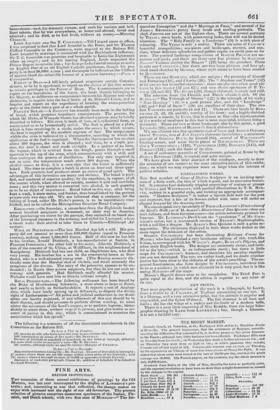• FINE ARTS.
BRITISH INSTITUTION.
'THE succession of these annual exhibitions of paintings by the Old Masters, was last year interrupted by the dissilay of LAWRENCE'S portraits; and, interesting as was that collection' the change makes us -enjoy with increased zest the sight of our old favourites. The present selection of pictures comprises numerous specimens of the Italian Flemish, and Dutch schools, with two fine ones of lguniuso—" The Ina maculate Conception " and the " Marriage at Cana," and several of Sir JOSHUA REYNOLDS'S pretty fancy heads and sterling portraits. The chefs d 'enures are not of the highest class. There are several portraits by TITIAN ; stern heads, with penetrating looks, that will not be denied attention. The " Holy Family in a Landscape" (5) is a rich piece of colouring. The Venus is only a nudity. There are some of CLAUDE'S. beautiful tranquiliities ; sea-pieces and landscapes, sunsets, and sun. rises, whose delicious splendours and golden repose we could gaze on for ever. The poetical landscape compositions of GASPAR. POUSSIN are nu-, merous and good ; and there are three very fine pictures by SALVATOR Rusa—" Cadmus slaying the Dragon " (70) being the grandest. There is only one CANALETTr ; but there are two large pictures and four spirited small sketches by GUARD!, whose style seems to have been studied by DONINGTON.
There are two RAPHAELS, which are unique ; the portraits of himself and Fornarina (19), and Charity (26). The " Absalom and Tamar" (52) of GUERCINO has beautiful expression : there are also two other good pictures by this master (37 and 67) ; and two choice specimens of P. TtDALDI (25 and 31). The GUIDO (29), though elaborate, is crude and cold. The selection from the Flemish and Dutch schools is rich. Of the ar.xsxs " The Triumph of Silent's " (47) is the triumph of his style ; " Bear Hunting " (48) is a good picture also ; andhis " Landscape" (46) and " Fall of Snow " (50) are excellent of their class. The two best VANDYKES are portraits (4 and 17). There are four heads by REM. BRANDT (8, 42, 53, and 85), worthy of his dime; and a highly-finished. portrait of a female, by CUYP, that is almost as fine—the representation. of the marks of small-pox in this face is most successful, without being a deformity. There are two or three landscapes also by this artist, a good Rtsvsnant. (99), and two of HORDINA'S literal elaborations.' We are afforded two fine specimens each of ISAAC and ADRIAN ()STADE; two of TE:nans, two of JAN STEEN'S elaborate bestialities ; a miniature portrait of GERARD DOUW, by himself (65), several of WouvEnnases hunting-scenes, and smile battle pieces of BOURGOGNONE. There are also a VANDERCAPET.T.A ( 118), VANDERNEER (129), Bmtunnar (145), and Ilcmaans (157), each the finest of its class.
A set of caricature-portraits of Connoisseurs, painted at Rome by Sir: JOSHUA REYNOLDS (133), is capital, and quite unique.
We have given this brief abstract of the catalogue, merely to draw the attention of our readers to the most attractive points of this exhibb: don; on which we may expatiate more at large when the interest of politics subsides.
EMBELLISHED WORKS.
THE first number of Gems of Modern Sculpture is an inviting specimen of a little work, the idea of which is good, and its execution beauti. ful. It contains four delicately stippled engravings of statues or groups by CANOVA and WESTMACOTT, with poetical illustrations by T. K. HER.. VEY, written in a graceful style, and forming an appropriate accompaniment. " Modern Sculpture" is rather a barren field both for the poet and engraver, but a few of its flowers culled with taste will make an elegant bouquet for the drawing-room. We cannot speak very favoerably of Tiro:HAS LANDSEER'S Mustrationsof the Devil's Walk ; or of H. ALKEN'S Illustrations of Don Quixote :they are both failures, and from the same cause—the artists substitute grimace for humour. Mr. LANDSEER'S Devil is not the " gentleman" of Mr. COLE. nroua's satire, but a scaramonch version of RETSCH'S Mephistopheles, with a tail like a dragon. Mr. Armes's Don Quixote is only a grim exaggeration. The cleverness displayed in both these works makes us the more regret the mistakes of the artists. • GEORGE CM:INS/TANK has been illustrating Robinson Crusoe for MAJOR ; who has published a very handsome edition of this truth-like fiction, to correspond with his War:rox's Angler, RUNYAN'S Pilgrim, and other truly English books. The designs are extremely clever, and faithful to the text,—which is an indispensable merit ; but there is little scope for CRUIKSTIANK'S humour, and therefore his peculiar excellencies are not developed. The cuts are rather hard,.and we doubt whether justice has been done to the richness of the artist's pencilling. The engraved frontispieces, also from designs by CREIKSITANK, introduce him to us as a painter ; in which new character he is very good, but it is like seeing IllaTnaws off the stage. Mason's Hogarth draws near to its completion. The Third Part is quite equal to the first, and the edition is superior to any other of its size.
NEW PRINTS.
THE most popular production of the week is a lithograph, by LANE, from a sketch by A. CHALON, of Taglioni pirouetting on one toe. It is a likeness, and a very attractive print, but the attitude is angular and ungraceful, and the figure ill-drawn. The fair danseuse is all bust and limbs; she has the wings of a zephyr and the bustle of a modern belle. There is a neat little engraving of Miss Kemble, from the large litho-graphic drawing by LANE from LAWRENCE; but, though a likeness, it is not a faithful copy.
























 Previous page
Previous page